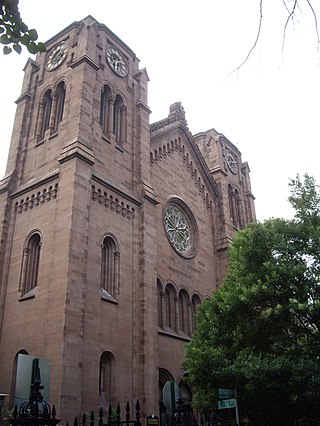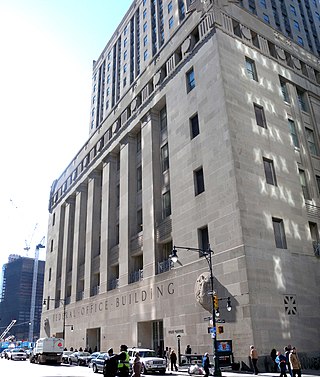Trinity Church is a historic parish church in the Episcopal Diocese of New York, at the intersection of Wall Street and Broadway in the Financial District of Lower Manhattan in New York City. Known for its history, location, architecture and endowment, Trinity is a traditional high church, with an active parish centered around the Episcopal Church and the worldwide Anglican Communion in missionary, outreach, and fellowship. In addition to its main facility, Trinity operates two chapels: St. Paul's Chapel, and the Chapel of St. Cornelius the Centurion on Governors Island. The Church of the Intercession, the Trinity Chapel Complex and many other of Anglican congregations in Manhattan were part of Trinity at one point. Columbia University was founded on the church's grounds as King's College in 1754.

St. Michael's Church is a historic Episcopal church at 225 West 99th Street and Amsterdam Avenue on Manhattan's Upper West Side in New York City. The parish was founded on the present site in January 1807, at that time in the rural Bloomingdale District. The present limestone Romanesque building, the third on the site, was built in 1890–91 to designs by Robert W. Gibson and added to the National Register of Historic Places in 1996.

The Church of St. Vincent Ferrer is a Roman Catholic parish in the Upper East Side of Manhattan, New York City. It was built in 1918 by the Dominicans; the attached priory serves as the headquarters of the Eastern United States Province of the order. Its architecture has some unusual features: above the front entrance is one of the few statues of the Crucifixion on the exterior of an American Catholic church; and inside, the Stations of the Cross depict Christ with oil paintings instead of statuary or carvings. It has two Schantz pipe organs. The church building, at the corner of Lexington Avenue and East 66th Street in the Lenox Hill section of the Upper East Side, has been called "one of New York's greatest architectural adornments."

The First Hungarian Reformed Church of New York is located on East 69th Street in the Upper East Side of the New York City borough of Manhattan. It is a stucco-faced brick building, completed in 1916 in a Hungarian vernacular architectural style, housing a congregation established in 1895.

St. George's Episcopal Church is a historic church located at 209 East 16th Street at Rutherford Place, on Stuyvesant Square in Manhattan, New York City. Called "one of the first and most significant examples of Early Romanesque Revival church architecture in America", the church exterior was designed by Charles Otto Blesch and the interior by Leopold Eidlitz. It is one of the two sanctuaries of the Calvary-St. George's Parish.
Minard Lafever (1798–1854) was an American architect of churches and houses in the United States in the early nineteenth century.

St. Andrew's Episcopal Church is a historic Episcopal church located at 2067 Fifth Avenue at 127th Street in the neighborhood of Harlem in Manhattan, New York City. Built in 1872, it was designed by noted New York City architect Henry M. Congdon (1834–1922) in the Gothic Revival style. It features a 125 foot tall clock tower surmounted by a slate covered spire surrounded by four towerlets.

St. Cecilia Church is a Roman Catholic parish church in the Roman Catholic Archdiocese of New York and a historic landmark located at 120 East 106th Street between Park Avenue and Lexington Avenue, Manhattan, New York City, New York. The parish was established in 1873. It was staffed by the Redemptorist Fathers from 1939 to 2007. The church was designated a New York City landmark in 1976. The church and convent were listed on the U.S. National Register of Historic Places in 1984.

Church Street and Trinity Place form a single northbound roadway in Lower Manhattan, New York City. Its northern end is at Canal Street and its southern end is at Morris Street, where Trinity Place merges with Greenwich Street. The dividing point is Liberty Street.

St. Augustine's Church is located at 290 Henry Street between Montgomery and Jackson Streets on the Lower East Side of Manhattan, New York City.

The Church of the Immaculate Conception and Clergy House at 406–412 East 14th Street between First Avenue and Avenue A in the East Village neighborhood of Manhattan, New York City were built in 1894–1896 by Grace Church, one of the most prominent Episcopal churches in the city at the time. The buildings were a free chapel – meaning there was no pew rent – called Grace Chapel and a connected Grace Hospital, which could serve 16 senior citizens and 10 children, and was physically connected to the chapel by a bridge, so that patients could be wheeled to services.

J. William Schickel, FAIA, (1850–1907) known professionally as William Schickel, was a German-American architect and founder of the New York architectural firm of Schickel & Ditmars.

The Church of the Holy Trinity is an Episcopal parish church located at 316 East 88th Street between First and Second Avenues in the Yorkville neighborhood of Manhattan, New York City.

The Red House is a 1903 apartment building on the Upper West Side of Manhattan in New York City. It was built on land owned by Canadian architect R. Thomas Short of the Beaux-Arts firm, Harde & Short. He and his firm designed and built the building in a free eclectic mix of French late Gothic. and English Renaissance motifs, using red brick and limestone with bold black-painted mullions in the fenestration. The salamander badge of Henri II appears high on the flanking wings and in the portico frieze. The center is recessed, behind a triple-arched screen.

The Park Avenue Houses in New York City were built in 1909. They were added to the National Register of Historic Places in 1980.

The Mrs. Graham Fair Vanderbilt House is a mansion located at 60 East 93rd Street on the Upper East Side of Manhattan in New York City. It was added to the National Register of Historic Places on October 29, 1982.

203 East 29th Street is a historic house and carriage house located between Second and Third Avenues in the Kips Bay neighborhood of Manhattan, New York City, one of a small number of wooden houses that remain on Manhattan Island. The year the house was built is uncertain, having been variously dated from as early as around 1790 to as late as 1870.

The Lucy Drexel Dahlgren House is a historic home located at 15 East 96th Street between Fifth and Madison Avenues on the border between the Carnegie Hill and East Harlem neighborhoods of the Upper East Side of Manhattan, New York City.

The 12 rowhouses at 322–344 East 69th Street are located on the south side of that street between First and Second avenues on the Upper East Side of the New York City borough of Manhattan. They are Neo-Grec brownstone structures built around 1879, in two sets designed by different architects.

George Willard Conable (1866-1933), AIA, was an American architect practicing in New York City in the early to mid 20th century specializing in churches.























